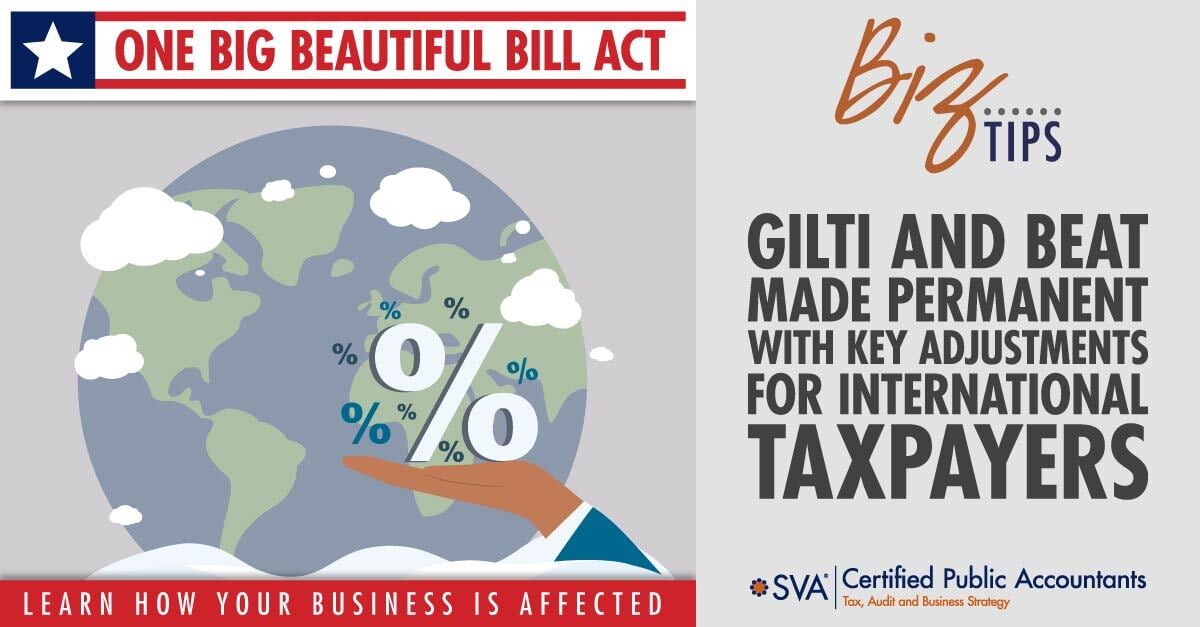| Highlights: |
- Summarizes key international tax changes under the One Big Beautiful Bill Act, including updates to GILTI (now NCTI) and BEAT that affect U.S. multinationals with foreign operations.
- Explains how modifications to GILTI’s base, effective tax rate, foreign tax credits, and expense allocation broaden the taxable income scope and impact tax planning.
- Covers BEAT’s rate adjustment to 10.5%, continued credit treatment, and practical implications for businesses with significant related-party cross-border payments.
|
The One Big Beautiful Bill Act (OBBBA) cements two significant international tax provisions: the Global Intangible Low-Taxed Income (GILTI) rules and the Base Erosion and Anti-Abuse Tax (BEAT), while making several updates that will affect U.S. corporations with foreign operations.
A Quick Refresher on GILTI
GILTI was created to discourage U.S. companies from shifting profits to low-tax jurisdictions. It applies to U.S. shareholders of Controlled Foreign Corporations (CFCs) and generally taxed certain foreign income that exceeded a 10% deemed return on the CFC’s tangible assets, known as the Qualified Business Asset Investment (QBAI) exclusion.
Before OBBBA:
- Corporations (and individuals making a Section 962 election) could deduct 50% of GILTI under Section 250, resulting in an effective tax rate of 10.5% before foreign tax credits (FTCs).
- An 80% FTC was allowed for foreign taxes paid or accrued on GILTI income. If the foreign tax rate was at least 13.125%, no additional U.S. tax was due.
(Dowload Video Transcript)
What OBBBA Changes for GILTI (Now NCTI)
OBBBA renames GILTI as Net CFC Tested Income (NCTI) and makes several changes beginning in tax years after December 31, 2025:
1. Higher Effective Tax Rate
- Section 250 deduction drops from 50% to 40%, increasing the effective rate from 10.5% to approximately 12.6% before FTCs.
2. Elimination of the QBAI Exclusion
- All CFC income (with limited exceptions) is now included in the NCTI base, broadening the scope.
3. Increased Foreign Tax Credit Allowance
- FTC percentage rises from 80% to 90% of foreign taxes paid or accrued. With a foreign tax rate of at least 14%, no additional U.S. tax should be due.
4. Expense Allocation Changes
- Any other deductions only allowed if such deductions are directly allocable to such income.
- Interest and R&D expenses are no longer allocated to foreign-source NCTI, potentially increasing usable FTCs.
5. Other Notable Adjustments
- US Shareholders will include pro rata share of Subpart F and NCTI if they held stock of a CFC at any point during the CFC’s tax year.
- The downward attribution limitation is restored, narrowing the entities treated as CFCs.
- Section 954(c)(6) CFC look-through rule is made permanent, providing long-term certainty for cross-border intercompany transactions. Year-end rule will only apply to section 956.
A Quick Refresher on BEAT
BEAT is a minimum tax targeting large multinational companies operating in the U.S. that make significant deductible payments to foreign affiliates. It aims to deter profit shifting through “base erosion” payments like interest, royalties, rent, and certain service fees.
It applies to domestic C corporations (excluding S corps, REITs, RICs) that meet the average annual gross receipts of at least $500 million over the prior three years who have a base erosion percentage of 3% or more.
Before OBBBA:
- The Base Erosion Minimum Tax Amount (BEMTA) was 10% of modified taxable income (MTI), with a planned increase to 12.5% after 2025.
- Taxpayers could offset BEAT liability with certain U.S. tax credits, with favorable treatment for R&D credits.
What the OBBBA Changes for BEAT
| Rate Adjustment |
Instead of rising to 12.5%, the rate will be 10.5% for years ending after December 31, 2025. |
| Credit Treatment Preserved |
R&D and certain other credits can still offset BEAT liability. |
| No High-Tax Exception |
Payments to high-tax jurisdictions (18.9%+ effective rate) are still subject to BEAT, an exception that was proposed but ultimately not included. |
How This Affects Business Owners
For companies with CFCs, the NCTI changes expand the income base while increasing the effective rate. The higher FTC percentage may soften the blow for businesses operating in moderate-to-high tax jurisdictions, but those in lower-tax countries could see higher U.S. tax bills.
On the BEAT side, the smaller-than-expected rate increase and the continued ability to use certain credits are favorable developments, but businesses making significant related-party payments abroad will still need to evaluate their exposure.
What to Do Now
| Model the Impact |
Review your foreign tax profile to see how the new NCTI rules interact with the increased FTC percentage. |
| Review Expense Allocations |
The elimination of certain expense allocations to NCTI may change how you approach R&D and interest costs. |
| Assess BEAT Exposure |
Revisit your related-party payment structures to understand how the 10.5% rate will apply post-2025. |
With GILTI and BEAT now permanent, the rules of the game are set. The right planning today can help you minimize surprises and optimize your global tax position tomorrow.
© 2025 SVA Certified Public Accountants

